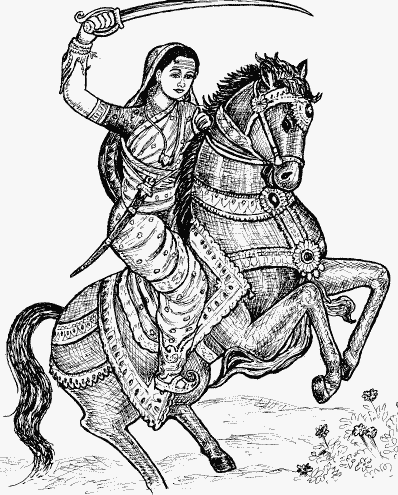In the annals of India’s history, there are figures who rise above the ordinary and become symbols of bravery, resilience, and the unwavering spirit of freedom. Rani Laxmi Bai, also known as the Queen of Jhansi, stands tall among them. Born on November 19, 1828, in Varanasi, India, she became an emblem of courage and defiance during the Indian Rebellion of 1857 against British rule. From her valiant leadership in battles to her unyielding determination, Rani Laxmi Bai’s story continues to inspire generations, making her an enduring icon in the fight for India’s independence. In this blog post we will share 10 points about Rani Laxmi bai.
These 10 points about Rani Laxmi Bai will delve into various aspects of Rani Laxmi Bai’s life, shedding light on her indomitable spirit, leadership, and enduring legacy.
10 points about Rani Laxmi Bai
Point 1: Birth

Rani Laxmi Bai, born on November 19, 1828, in Varanasi, India, was a courageous and influential figure in the Indian Rebellion of 1857, also known as the Sepoy Mutiny or the First War of Independence against British rule.
Must Read: 10 Interesting Facts and Information About the Neem Tree
Point 2: Early Life and Marriage
She was born as Manikarnika Tambe and later renamed as Laxmi Bai after her marriage to Maharaja Gangadhar Rao Newalkar of Jhansi in 1842.
Point 3: Dispute Over Succession
After her husband’s death in 1853, the British East India Company refused to recognize her son as the heir to the throne of Jhansi, leading to a dispute over the kingdom’s succession.
Must Read: Cricket 101: Interesting Facts About Cricket
Point 4: Defending Jhansi

In March 1858, the British forces attacked Jhansi, and Rani Laxmi Bai bravely defended her kingdom. She personally led her troops and fought fiercely against the British, displaying exceptional courage and military skills.
Point 5: Inspiring Leadership
Rani Laxmi Bai’s leadership and determination inspired her soldiers to fight valiantly, and they inflicted significant casualties on the British forces during the siege of Jhansi.
Must Read: 10 Facts about Constitution of India: An In-Depth Exploration
Point 6: Escape and Guerrilla Campaign
Despite the brave resistance, Jhansi eventually fell to the British, forcing Rani Laxmi Bai to escape the city with a small group of loyal followers. She continued to organize and lead a guerilla campaign against the British forces.
Point 7: Alliances and Participation
Rani Laxmi Bai sought alliances with other rebel leaders, including Tatya Tope and Nana Sahib, to strengthen the fight against British rule. She actively participated in various battles and engagements during the rebellion.
Must Read: Decoding the Facts About Boys: The Boys Blueprint
Point 8: The Battle of Gwalior

On June 18, 1858, Rani Laxmi Bai fought a decisive battle at Gwalior against the British forces. Though heavily outnumbered, she displayed exceptional bravery and led a valiant charge. Unfortunately, she was critically wounded and succumbed to her injuries.
Point 9: Symbol of Indian Resistance
Rani Laxmi Bai’s defiance and sacrifice in the face of British imperialism made her a revered symbol of Indian resistance. She is often hailed as “Jhansi Ki Rani” (the queen of Jhansi) and is remembered as one of the key figures in India’s fight for independence.
Must Read: 10 Most Expensive Things in India
Point 10: Enduring Legacy
Her legacy as a fearless warrior and a national hero endures, and her story continues to inspire people across India. Rani Laxmi Bai’s contributions to the struggle for freedom remain an integral part of India’s history and serve as a reminder of the indomitable spirit of those who fought for independence.
We hope that these 10 points about Rani Laxmi Bai have helped you understand who she was and why she is respected and celebrated in India.
But believe us, these 10 points about Rani Laxmi Bai were just a summarized part of her remarkable life, and they cannot fully encompass her great legacy. She accomplished numerous incredible feats. If you wish to delve deeper into the extraordinary story of Rani Laxmi Bai, you can read more about her here: https://en.wikipedia.org/wiki/Rani_of_Jhansi

